1.1 The Process of Science
Understanding Science
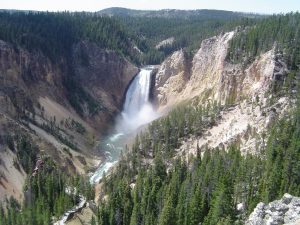
Scientists seek to understand the fundamental principles that explain natural patterns and processes. Science is more than just a body of knowledge, science provides a means to evaluate and create new knowledge without bias. Scientists use objective evidence over subjective or interpreted evidence, to reach sound and logical conclusions.
An objective observation is without personal bias and the same by all individuals. Humans are biased by nature, so they cannot be completely objective; the goal is to be as unbiased as possible. A subjective observation or interpretation is based on a person’s feelings and beliefs and is unique to that individual.
Another way scientists avoid bias is by using quantitative over qualitative measurements whenever possible. Quantitative measurements are expressed with a specific numerical value. Qualitative observations are general or relative descriptions. For example, describing a rock as red or heavy is a qualitative observation. Although, determining a rock’s color by measuring wavelengths of reflected light or its density by measuring the proportions of minerals it contains is quantitative. Numerical values are more precise than general descriptions, and they can be analyzed using statistical calculations. This is why quantitative measurements are much more useful to scientists than qualitative observations.
Establishing truth in science is difficult because all scientific claims are falsifiable, which means any initial hypothesis may be tested and proven false. Only after exhaustively eliminating false results, competing ideas, and possible variations does a hypothesis become regarded as a reliable scientific theory. This meticulous scrutiny reveals weaknesses or flaws in a hypothesis and is the strength that supports all scientific ideas and procedures. In fact, proving current ideas are wrong has been the driving force behind many scientific careers.
Falsifiability separates science from pseudoscience. Scientists are wary of explanations of natural phenomena that discourage or avoid falsifiability. An explanation that cannot be tested or does not meet scientific standards is not considered science, but pseudoscience. Pseudoscience is a collection of ideas that may appear scientific but do not use the scientific method. Astrology is an example of pseudoscience. It is a belief system that attributes the movement of celestial bodies to influencing human behavior. Astrologers rely on celestial observations, but their conclusions are not based on experimental evidence and their statements are not falsifiable. This is not to be confused with astronomy which is the scientific study of celestial bodies and the cosmos.
Science is also a social process. Scientists share their ideas with peers at conferences, seeking guidance and feedback. Research papers and data submitted for publication are rigorously reviewed by qualified peers, scientists who are experts in the same field. The scientific review process aims to weed out misinformation, invalid research results, and wild speculation. Thus, it is slow, cautious, and conservative. Scientists tend to wait until a hypothesis is supported by an overwhelming amount of evidence from many independent researchers before accepting it as a scientific theory.
The Scientific Method
Modern science is based on the scientific method, a procedure that follows these steps:
![Source: By ArchonMagnus (Own work) [<a href="http://creativecommons.org/licenses/by-sa/4.0">CC BY-SA 4.0</a>], <a href="https://commons.wikimedia.org/wiki/File%3AThe_Scientific_Method_as_an_Ongoing_Process.svg">via Wikimedia Commons</a> Diagram illustrates how the scientific method is a cyclical, self-repeating process that starts with Obserations, proceeds to a Hypothesis, then Tests the Hypothesis for which Testable Predictions are made, from which the hypothesis is then accepted, refined, or rejected.. if accepted.. more data is then gathered to test the predictions, and develop general theories, the last step.](https://opengeology.org/textbook/wp-content/uploads/2016/07/The_Scientific_Method_as_an_Ongoing_Process.svg_-300x247.png)
- Formulate a question or observe a problem
- Apply objective experimentation and observation
- Analyze collected data and Interpret results
- Devise an evidence-based theory
- Submit findings to peer review and/or publication
This has a long history in human thought but was first fully formed by Ibn al-Haytham over 1,000 years ago. At the forefront of the scientific method are conclusions based on objective evidence, not opinion or hearsay.
STEP ONE: OBSERVATION, PROBLEM, OR RESEARCH QUESTION
The procedure begins with identifying a problem or research question, such as a geological phenomenon that is not well explained in the scientific community’s collective knowledge. This step usually involves reviewing the scientific literature to understand previous studies that may be related to the question.
STEP TWO: HYPOTHESIS
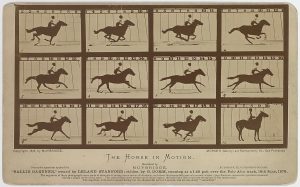
Once the problem or question is well defined, the scientist proposes a possible answer, a hypothesis, before conducting an experiment or field work. This hypothesis must be specific, falsifiable, and should be based on other scientific work. Geologists often develop multiple working hypotheses because they usually cannot impose strict experimental controls or have limited opportunities to visit a field location.
STEP THREE: EXPERIMENT AND HYPOTHESIS REVISION
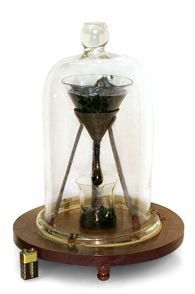
The next step is developing an experiment that either supports or refutes the hypothesis. Many people mistakenly think experiments are only done in a lab; however, an experiment can consist of observing natural processes in the field. Regardless of what form an experiment takes, it always includes the systematic gathering of objective data. This data is interpreted to determine whether it contradicts or supports the hypothesis, which may be revised and tested again. When a hypothesis holds up under experimentation, it is ready to be shared with other experts in the field.
STEP FOUR: PEER REVIEW, PUBLICATION, AND REPLICATION
Scientists share the results of their research by publishing articles in scientific journals, such as Science and Nature. Reputable journals and publishing houses will not publish an experimental study until they have determined its methods are scientifically rigorous and the conclusions are supported by evidence. Before an article is published, it undergoes a rigorous peer review by scientific experts who scrutinize the methods, results, and discussion. Once an article is published, other scientists may attempt to replicate the results. This replication is necessary to confirm the reliability of the study’s reported results. A hypothesis that seemed compelling in one study might be proven false in studies conducted by other scientists. New technology can be applied to published studies, which can aid in confirming or rejecting once-accepted ideas and/or hypotheses.
STEP FIVE: THEORY DEVELOPMENT
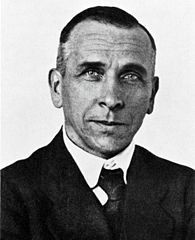
In casual conversation, the word theory implies guesswork or speculation. In the language of science, an explanation or conclusion made in a theory carries much more weight because it is supported by experimental verification and widely accepted by the scientific community. After a hypothesis has been repeatedly tested for falsifiability through documented and independent studies, it eventually becomes accepted as a scientific theory.
While a hypothesis provides a tentative explanation before an experiment, a theory is the best explanation after being confirmed by multiple independent experiments. Confirmation of a theory may take years, or even longer. For example, the continental drift hypothesis first proposed by Alfred Wegener in 1912 was initially dismissed. After decades of additional evidence collection by other scientists using more advanced technology, Wegener’s hypothesis was accepted and revised as the theory of plate tectonics.
The theory of evolution by natural selection is another example. Originating from the work of Charles Darwin in the mid-19th century, the theory of evolution has withstood generations of scientific testing for falsifiability. While it has been updated and revised to accommodate knowledge gained by using modern technologies, the theory of evolution continues to be supported by the latest evidence.
Early Scientific Thought
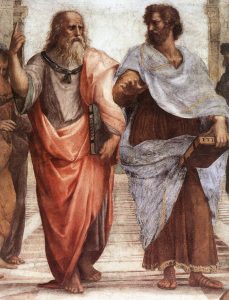
Western scientific thought began in the ancient city of Athens, Greece. Athens was governed as a democracy, which encouraged individuals to think independently, at a time when most civilizations were ruled by monarchies or military conquerors. Foremost among the early philosopher/scientists to use empirical thinking was Aristotle, born in 384 BCE. Empiricism emphasizes the value of evidence gained from experimentation and observation. Aristotle studied under Plato and tutored Alexander the Great. Alexander would later conquer the Persian Empire, and in the process spread Greek culture as far east as India.
Aristotle applied an empirical method of analysis called deductive reasoning, which applies known principles of thought to establish new ideas or predict new outcomes. Deductive reasoning starts with generalized principles and logically extends them to new ideas or specific conclusions. If the initial principle is valid, then it is highly likely the conclusion is also valid. An example of deductive reasoning is if A=B, and B=C, then A=C. Another example is if all birds have feathers, and a sparrow is a bird, then a sparrow must also have feathers. The problem with deductive reasoning is if the initial principle is flawed, the conclusion will inherit that flaw. Here is an example of a flawed initial principle leading to the wrong conclusion; if all animals that fly are birds, and bats also fly, then bats must also be birds.
This type of empirical thinking contrasts with inductive reasoning, which begins from new observations and attempts to discern underlying generalized principles. A conclusion made through inductive reasoning comes from analyzing measurable evidence, rather than making a logical connection. For example, to determine whether bats are birds a scientist might list various characteristics observed in birds–the presence of feathers, a toothless beak, hollow bones, lack of forelegs, and externally laid eggs. Next, the scientist would check whether bats share the same characteristics, and if they do not, draw the conclusion that bats are not birds.
Both types of reasoning are important in science because they emphasize the two most important aspects of science: observation and inference. Scientists test existing principles to see if they accurately infer or predict their observations. They also analyze new observations to determine if the inferred underlying principles still support them.
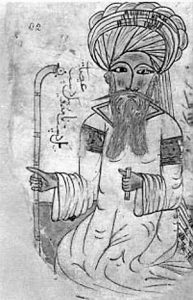
Greek culture was spread by Alexander and then absorbed by the Romans, who help further extend Greek knowledge into Europe through their vast infrastructure of roads, bridges, and aqueducts. After the fall of the Roman Empire in 476 CE, scientific progress in Europe stalled. Scientific thinkers of medieval time had such high regard for Aristotle’s wisdom and knowledge they faithfully followed his logical approach to understanding nature for centuries. By contrast, science in the Middle East flourished and grew between 800 and 1450 CE, along with culture and the arts.
Near the end of the medieval period, empirical experimentation became more common in Europe. During the Renaissance, which lasted from the 14th through 17th centuries, artistic and scientific thought experienced a great awakening. European scholars began to criticize the traditional Aristotelian approach and by the end of the Renaissance period, empiricism was poised to become a key component of the scientific revolution that would arise in the 17th century.
An early example of how Renaissance scientists began to apply a modern empirical approach is their study of the solar system. In the second century, the Greek astronomer Claudius Ptolemy observed the Sun, Moon, and stars moving across the sky. Applying Aristotelian logic to his astronomical calculations, he deductively reasoned all celestial bodies orbited around the Earth, which was located at the center of the universe. Ptolemy was a highly regarded mathe
matician, and his mathematical calculations were widely accepted by the scientific community. The view of the cosmos with Earth at its center is called the geocentric model. This geocentric model persisted until the Renaissance period, when some revolutionary thinkers challenged the centuries-old hypothesis.
By contrast, early Renaissance scholars such as astronomer Nicolaus Cop
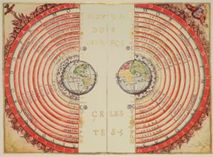
ernicus (1473-1543) proposed an alternative explanation for the perceived movement of the Sun, Moon, and stars. Sometime between 1507 and 1515, he provided credible mathematical proof for a radically new model of the cosmos, one in which the Earth and other planets orbited around a centrally located Sun. After the invention of the telescope in 1608, scientists used their enhanced astronomical observations to support this heliocentric, Sun-centered, model.
Two scientists, Johannes Kepler and Galileo Galilei, are credited with jump-starting the scientific revolution. They accomplished this by building on the work of Copernicus and challenging long-established ideas about nature and science.
Johannes Kepler (1571-1630) was a German mathematician and astronomer who expanded on the heliocentric model—improving Copernicus’ original calculations and describing planetary motion
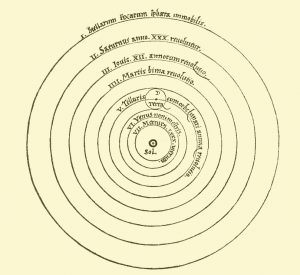
as elliptical paths. Galileo Galilei (1564 – 1642) was an Italian astronomer who used the newly developed telescope to observe the four largest moons of Jupiter. This was the first piece of direct evidence to contradict the geocentric model since moons orbiting Jupiter could not also be orbiting Earth.
Galileo strongly supported the heliocentric model and attacked the geocentric model, arguing for a more scientific approach to determine the credibility of an idea. Because of this, he found himself at odds with prevailing scientific views and the Catholic Church. In 1633 he was found guilty of heresy and placed under house arrest, where he would remain until his death in 1642.
Galileo is regarded as the first modern scientist because he conducted experiments that would prove or disprove falsifiable ideas and based his conclusions on mathematical analysis of quantifiable evidence—a radical departure from the deductive thinking of Greek philosophers such as Aristotle. His methods marked the beginning of a major shift in how scientists studied the natural world, with an increasing number of them relying on evidence and experimentation to form their hypotheses. It was during this revolutionary time that geologists such as James Hutton and Nicolas Steno also made great advances in their scientific fields of study.
Science Denial and Evaluating Sources
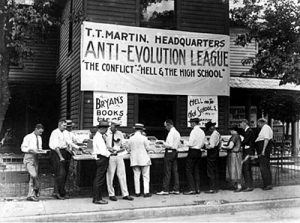
Introductory science courses usually deal with accepted scientific theory and do not include opposing ideas, even though these alternate ideas may be credible. This makes it easier for students to understand the complex material. Advanced students will encounter more controversies as they continue to study their discipline.
Some groups of people argue that some established scientific theories are wrong, not based on their scientific merit but rather on the ideology of the group. This section focuses on how to identify evidence based information and differentiate it from pseudoscience.
Science Denial
Science denial happens when people argue that established scientific theories are wrong, not based on scientific merit but rather on subjective ideology—such as for social, political, or economic reasons. Organizations and people use science denial as a rhetorical argument against issues or ideas they oppose. Three examples of science denial versus science are: 1) teaching evolution in public schools, 2) linking tobacco smoke to cancer, and 3) linking human activity to climate change. Among these, denial of climate change is strongly connected with geology. A climate denier specifically denies or doubts the objective conclusions of geologists and climate scientists.
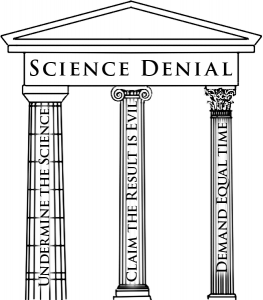
Science denial generally uses three false arguments. The first argument tries to undermine the credibility of the scientific conclusion by claiming the research methods are flawed or the theory is not universally accepted—the science is unsettled. The notion that scientific ideas are not absolute creates doubt for non-scientists; however, a lack of universal truths should not be confused with scientific uncertainty. Because science is based on falsifiability, scientists avoid claiming universal truths and use language that conveys uncertainty. This allows scientific ideas to change and evolve as more evidence is uncovered.
The second argument claims the researchers are not objective and motivated by an ideology or economic agenda. This is an ad hominem argument in which a person’s character is attacked instead of the merit of their argument. They claim results have been manipulated so researchers can justify asking for more funding. They claim that because the researchers are funded by a federal grant, they are using their results to lobby for expanded government regulation.
The third argument is to demand a balanced view, equal time in media coverage and educational curricula, to engender the false illusion of two equally valid arguments. Science deniers frequently demand equal coverage of their proposals, even when there is little scientific evidence supporting their ideology. For example, science deniers might demand religious explanations be taught as an alternative to the well-established theory of evolution. Or that all possible causes of climate change be discussed as equally probable, regardless of the body of evidence. Conclusions derived using the scientific method should not be confused with those based on ideologies.
Furthermore, conclusions about nature derived from ideologies have no place in science research and education. For example, it would be inappropriate to teach the flat earth model in a modern geology course because this idea has been disproved by the scientific method. Unfortunately, widespread scientific illiteracy allows these arguments to be used to suppress scientific knowledge and spread misinformation.
The formation of new conclusions based on the scientific method is the only way to change scientific conclusions. We wouldn’t teach Flat Earth geology along with plate tectonics because the Flat Earth proponents don’t follow the scientific method. The fact that scientists avoid universal truths and change their ideas as more evidence is uncovered shouldn’t be seen as meaning that the science is unsettled. Because of widespread scientific illiteracy, these arguments are used by those who wish to suppress science and misinform the general public.
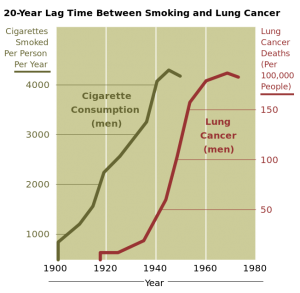
In a classic case of science denial, beginning in the 1960s and for the next three decades, the tobacco industry and their scientists used rhetorical arguments to deny a connection between tobacco usage and cancer. Once it became clear scientific studies overwhelmingly found that using tobacco dramatically increased a person’s likelihood of getting cancer, their next strategy was to create a sense of doubt about on the science. The tobacco industry suggested the results were not yet fully understood and more study was needed. They used this doubt to lobby for delaying legislative action that would warn consumers of the potential health hazards. This same tactic is currently being employed by those who deny the significance of human involvement in climate change.
Evaluating Sources of Information
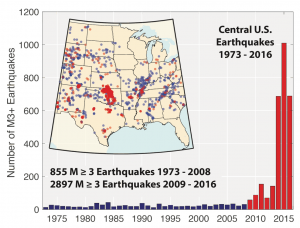
In the age of the internet, information is plentiful. Geologists, scientists, or anyone exploring scientific inquiry must discern valid sources of information from pseudoscience and misinformation. This evaluation is especially important in scientific research because scientific knowledge is respected for its reliability. Textbooks such as this one can aid this complex and crucial task. At its roots, quality information comes from the scientific method, beginning with the empirical thinking of Aristotle. The application of the scientific method helps produce unbiased results. A valid inference or interpretation is based on objective evidence or data. Credible data and inferences are clearly labeled, separated, and differentiated. Anyone looking over the data can understand how the author’s conclusion was derived or come to an alternative conclusion. Scientific procedures are clearly defined so the investigation can be replicated to confirm the original results or expanded further to produce new results. These measures make a scientific inquiry valid and its use as a source reputable. Of course, substandard work occasionally slips through and retractions are published from time to time. An infamous article linking the MMR vaccine to autism appeared in the highly reputable journal Lancet in 1998. Journalists discovered the author had multiple conflicts of interest and fabricated data, and the article was retracted in 2010.
In addition to methodology, data, and results, the authors of a study should be investigated. When looking into any research, the author(s) should be investigated. An author’s credibility is based on multiple factors, such as having a degree in a relevant topic or being funded from an unbiased source.
The same rigor should be applied to evaluating the publisher, ensuring the results reported come from an unbiased process. The publisher should be easy to discover. Good publishers will show the latest papers in the journal and make their contact information and identification clear. Reputable journals show their peer review style. Some journals are predatory, where they use unexplained and unnecessary fees to submit and access journals. Reputable journals have recognizable editorial boards. Often, a reliable journal will associate with a trade, association, or recognized open-source initiative.
One of the hallmarks of scientific research is peer review. Research should be transparent to peer review. This allows the scientific community to reproduce experimental results, correct and retract errors, and validate theories. This allows the reproduction of experimental results, corrections of errors, and proper justification of the research to experts.
Citation is not only imperative to avoid plagiarism, but also allows readers to investigate an author’s line of thought and conclusions. When reading scientific works, it is important to confirm the citations are from reputable scientific research. Most often, scientific citations are used to reference paraphrasing rather than quotes. The number of times a work is cited is said to measure the influence an investigation has within the scientific community, although this technique is inherently biased.References
Video: Earth Rocks – What is Science
- Adams, F.D., 1954, The birth and development of the geological sciences
- Alfe, D., Gillan, M.J., and Price, G.D., 2002, Composition and temperature of the Earth’s core constrained by combining ab initio calculations and seismic data: Earth Planet. Sci. Lett., v. 195, no. 1, p. 91–98.
- Alkin, M.C., 2004, Evaluation Roots: Tracing theorists’ views and influences: SAGE.
- Beckwith, C., 2013, How western Europe developed a full scientific method: Berfrois.
- Birch, F., 1952, Elasticity and constitution of the Earth’s interior: J. Geophys. Res., v. 57, no. 2, p. 227–286., doi: 10.1029/JZ057i002p00227.
- Bocking, S., 2004, Nature’s experts: science, politics, and the environment: Rutgers University Press.
- Chamberlin, T.C., 1890, The method of multiple working hypotheses: Science, v. 15, no. 366, p. 92–96.
- Cohen, H.F., 2010, How modern science came into the world: Four civilizations, one 17th-century breakthrough: Amsterdam University Press.
- Darwin, C., 1846, Geological Observations on South America: Being the Third Part of the Geology of the Voyage of the Beagle, Under the Command of Capt. Fitzroy, R.N. During the Years 1832 to 1836: Smith, Elder and Company.
- Drake, S., 1990, Galileo: Pioneer Scientist: University of Toronto Press.
- Engdahl, E.R., Flynn, E.A., and Masse, R.P., 1974, Differential PkiKP travel times and the radius of the core: Geophysical J Royal Astro Soc, v. 40, p. 457–463.
- Everitt, A., 2016, The Rise of Athens: The Story of the World’s Greatest Civilization:
- Goldstein, B.R., 2002, Copernicus and the origin of his heliocentric system: Journal for the History of Astronomy, v. 33, p. 219–235.
- Goldsworthy, A.K., 2011, The complete Roman army: Thames & Hudson.
- Hans Wedepohl, K., 1995, The composition of the continental crust: Geochim. Cosmochim. Acta, v. 59, no. 7, p. 1217–1232.
- Heilbron, J.L., 2012, Galileo: Oxford, Oxford University Press, 528 p.
- Hogendijk, J.P., and Sabra, A.I., 2003, The Enterprise of Science in Islam: New Perspectives: MIT Press.
- Jakosky, B.M., Grebowsky, J.M., Luhmann, J.G., Connerney, J., Eparvier, F., Ergun, R., Halekas, J., Larson, D., Mahaffy, P., McFadden, J., Mitchell, D.F., Schneider, N., Zurek, R., Bougher, S., and others, 2015, MAVEN observations of the response of Mars to an interplanetary coronal mass ejection: Science, v. 350, no. 6261, p. aad0210.
- Kerferd, G.B., 1959, The Biography of Aristotle Ingemar Düring: Aristotle in the Ancient Biographical Tradition. (Studia Graeca et Latina Gothoburgensia v.) Pp. 490; 1 plate. Gothenburg: Institute of Classical Studies, 1957. Paper, Kr. 32: Classical Rev., v. 9, no. 02, p. 128–130.
- Kolbert, E., 2014, The sixth extinction: an unnatural history: New York, Henry Holt and Co., 336 p.
- Krimsky, S., 2013, Do financial conflicts of interest bias research? An inquiry into the “funding effect” hypothesis: Sci. Technol. Human Values, v. 38, no. 4, p. 566–587.
- Lehmann, I., 1936, P’, Publ: Bur. Centr. Seism. Internat. Serie A, v. 14, p. 87–115.
- Marshall, J., 2010, A short history of Greek philosophy: Andrews UK Limited.
- Martin, C., 2014, Subverting Aristotle: Religion, History, and Philosophy in Early Modern Science: Baltimore : Johns Hopkins University Press.
- Mayr, E., 1942, Systematics and the Origin of Species, from the Viewpoint of a Zoologist: Harvard University Press.
- Montgomery, K., 2003, Siccar Point and teaching the history of geology: J. Geosci. Educ.
- Mooney, W.D., Laske, G., and Masters, T.G., 1998, CRUST 5.1: A global crustal model: J. Geophys. Res. [Solid Earth], v. 103, no. B1, p. 727–747.
- Moustafa, K., 2016, Aberration of the Citation: Account. Res., v. 23, no. 4, p. 230–244.
- National Center for Science Education, 2016, Climate change denial: Online, http://ncse.com/climate/denial, accessed April 2016.
- Oreskes, N., Conway, E., and Cain, S., 2010, Merchants of doubt: how a handful of scientists obscured the truth on issues from tobacco smoke to global warming: Bloomsbury Press, 368 p.
- Paradowski, R.J., 2012, Nicolas Steno: Danish anatomist and geologist: Great Lives from History: Scientists & Science, p. 830–832.
- Patterson, C., 1956, Age of meteorites and the earth: Geochim. Cosmochim. Acta, v. 10, no. 4, p. 230–237.
- Popper, K., 2002, Conjectures and Refutations: The Growth of Scientific Knowledge: London ; New York, Routledge, 608 p.
- Porter, R., 1976, Charles Lyell and the Principles of the History of Geology: Br. J. Hist. Sci., v. 9, no. 02, p. 91–103.
- Railsback, B.L., 1990, T. C. Chamberlin’s “Method of Multiple Working Hypotheses”: An encapsulation for modern students: Online, http://www.gly.uga.edu/railsback/railsback_chamberlin.html, accessed December 2016.
- Railsback, B.L., 2004, T. C. Chamberlin’s “Method of Multiple Working Hypotheses”: An encapsulation for modern students: Houston Geological Society Bulletin, v. 47, no. 2, p. 68–69.
- Rappaport, R., 1994, James Hutton and the History of Geology. Dennis R. Dean: Isis, v. 85, no. 3, p. 524–525.
- Repcheck, J., 2007, Copernicus’ secret: How the scientific revolution began: Simon and Schuster.
- Repcheck, J., 2009, The Man Who Found Time : James Hutton and the Discovery of the Earth’s Antiquity: New York: Basic Books.
- Sabra, A.I. and Others, 1989, The optics of Ibn al-Haytham: Books I-III: On direct vision: Warburg Institute, University of London.
- Saliba, G., 2007, Islamic science and the making of the European renaissance: MIT Press.
- Shermer, M., 2011, What Is Pseudoscience? Scientific American.
- Snow, C.E. (Ed.), 2016, Science literacy: concepts, contexts, and consequences: Washington, DC, National Academies Press (US).
- Spier, R., 2002, The history of the peer-review process: Trends Biotechnol., v. 20, no. 8, p. 357–358.
- Van Reybrouck, D., 2012, From Primitives to Primates: A History of Ethnographic and Primatological Analogies in the Study of Prehistory: Sidestone Press.
- Waters, C.N., Zalasiewicz, J., Summerhayes, C., Barnosky, A.D., Poirier, C., Ga\luszka, A., Cearreta, A., Edgeworth, M., Ellis, E.C., Ellis, M., Jeandel, C., Leinfelder, R., McNeill, J.R., Richter, D.D., and others, 2016, The Anthropocene is functionally and stratigraphically distinct from the Holocene: Science, v. 351, no. 6269, p. aad2622.
- de Wijs, G.A., Kresse, G., Vočadlo, L., Dobson, D., Alfè, D., Gillan, M.J., and Price, G.D., 1998, The viscosity of liquid iron at the physical conditions of the Earth’s core: Nature, v. 392, no. 6678, p. 805–807., doi: 10.1038/33905.
- Wyhe, J.V., 2008, Darwin: Andre Deutsch, 72 p.
- Wyllie, P.J., 1970, Ultramafic rocks and the upper mantle, in Morgan, B.A., editor, Fiftieth anniversary symposia: Mineralogy and petrology of the Upper Mantle; Sulfides; Mineralogy and geochemistry of non-marine evaporites: Washington, DC, Mineralogical Society of America, p. 3–32.
- Zalasiewicz, J., Williams, M., Smith, A., Barry, T.L., Coe, A.L., Bown, P.R., Brenchley, P., Cantrill, D., Gale, A., Gibbard, P., and Others, 2008, Are we now living in the Anthropocene? GSA Today, v. 18, no. 2, p. 4.
Licenses and Attributions
An Introduction to Geology. by Chris Johnson, Matthew D. Affolter, Paul Inkenbrandt, Cam Mosher of Salt Lake Community College. License: CC-BY-NC-SA 4.0
Adaptation: Renumbering, Remixing

